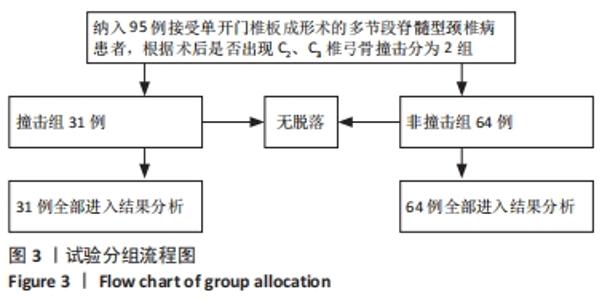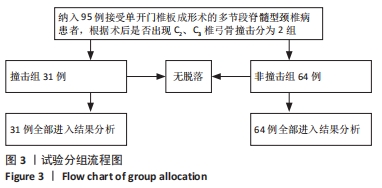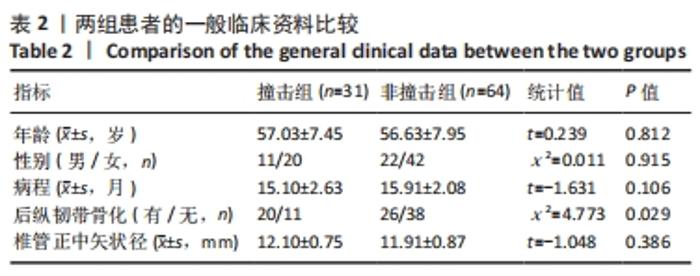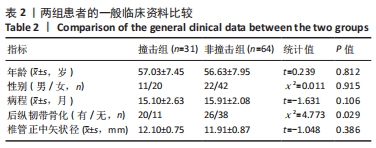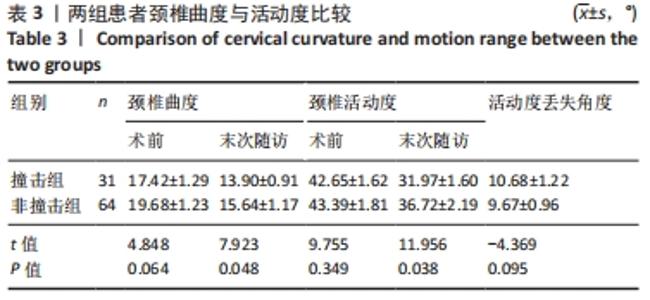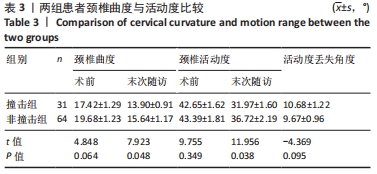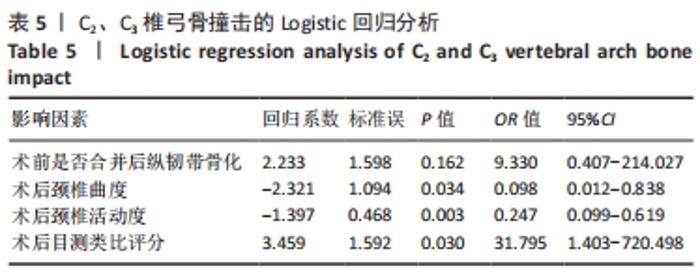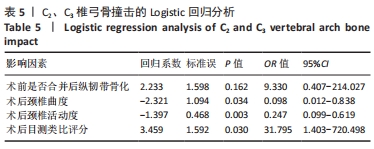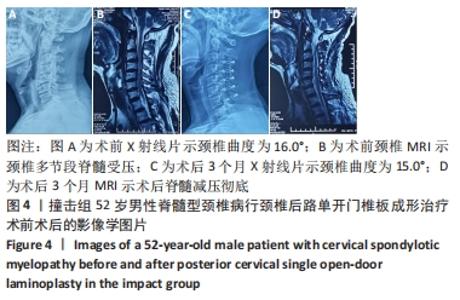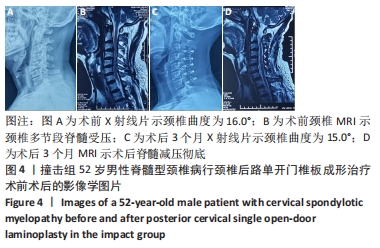Chinese Journal of Tissue Engineering Research ›› 2022, Vol. 26 ›› Issue (36): 5862-5867.doi: 10.12307/2022.793
Previous Articles Next Articles
C2 and C3 vertebral arch bone impact after posterior cervical single open-door laminoplasty: lateral X-ray evaluation of cervical spine within 2 years
Zhong Hua, Guan Haishan
- Department of Spine Surgery, Second Hospital of Shanxi Medical University, Taiyuan 030000, Shanxi Province, China
-
Received:2021-11-25Accepted:2021-12-31Online:2022-12-28Published:2022-04-27 -
Contact:Guan Haishan, MD, Chief physician, Department of Spine Surgery, Second Hospital of Shanxi Medical University, Taiyuan 030000, Shanxi Province, China -
About author:Zhong Hua, Master candidate, Department of Spine Surgery, Second Hospital of Shanxi Medical University, Taiyuan 030000, Shanxi Province, China
CLC Number:
Cite this article
Zhong Hua, Guan Haishan. C2 and C3 vertebral arch bone impact after posterior cervical single open-door laminoplasty: lateral X-ray evaluation of cervical spine within 2 years[J]. Chinese Journal of Tissue Engineering Research, 2022, 26(36): 5862-5867.
share this article
Add to citation manager EndNote|Reference Manager|ProCite|BibTeX|RefWorks
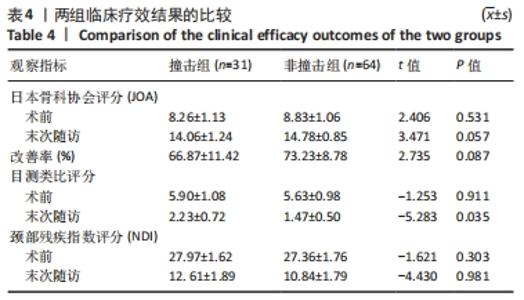
2.5 临床效果 两组末次随访时JOA评分均显著高于术前(P < 0.01)。术前及末次随访时撞击组JOA评分均低于非撞击组,但差异均无显著性意义(P > 0.05);两组JOA评分改善率比较差异无显著性意义(t=2.735,P=0.087)。两组末次随访时目测类比评分均显著低于术前(P < 0.01);术前撞击组目测类比评分高于非撞击组,但差异无显著性意义(P > 0.05);末次随访时,撞击组目测类比评分仍高于非撞击组,差异有显著性意义(P < 0.05)。两组末次随访时颈部残疾指数评分均显著低于术前,差异有显著性意义(P < 0.01);术前及末次随访时撞击组颈部残疾指数评分均高于非撞击组,但差异均无显著性意义(P > 0.05)。两组患者临床疗效的各项评分见表4。"
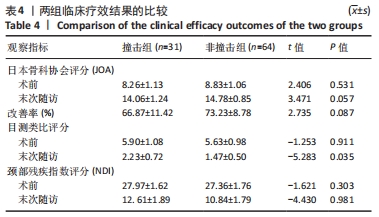
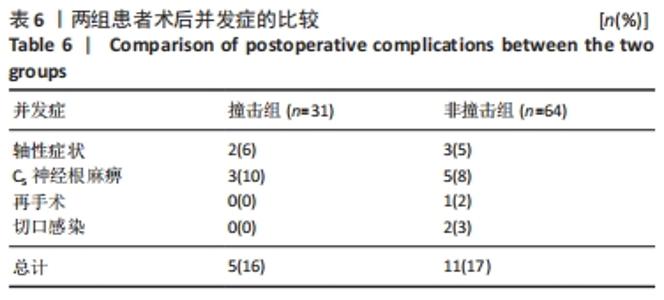
2.7 术后并发症 撞击组中2例术后出现轴性症状和体征,出现手臂外侧区麻木和疼痛,发生率为6.5%;非撞击组3例术后出现轴性症状,出现上臂疼痛,肩外展和肘关节屈曲无力,发生率为4.7%,两组患者的轴性症状经药物和物理治疗6-8周后逐渐恢复。撞击组中3例出现C5神经根麻痹,占9.7%,术后24 h内发生2例,术后1周内发生1例;非撞击组中5例出现C5神经根麻痹,占7.8%,术后24 h内发生3例,术后1周发生2例,两组患者C5神经根麻痹症状均在术后3个月内消失。非撞击组中1例在术后随访时发现内植物松动、移位,再次手术后神经功能恢复良好;非撞击组中2例术后出现切口感染,经清创术与额外药物治疗后切口愈合良好。随访期间未观察到与手术相关的其他并发症。 两组术后并发症发生率见表6。"
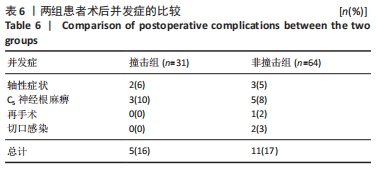
| [1] DUETZMANN S, COLE T, RATLIFF JK. Cervical laminoplasty developments and trends, 2003-2013: a systematic review. J Neurosurg Spine. 2015; 23:24-34. [2] 付信杰,孙宇.颈后路单开门椎管扩大椎板成形术术后远期并发症的研究现况[J].中华医学杂志,2020,100(45):3646-3648. [3] 张为,陈百成,申勇,等.颈3椎板切除单开门成形术对颈椎轴性症状的影响[J].中华骨科杂志,2006,26(8):544-548. [4] 朱小龙,徐卫星,丁伟国,等.颈椎单开门椎板成形术术后轴性症状的影响因素分析[J].中国骨伤,2018,31(11):1022-1026. [5] 谢水清,孙天威,田融,等.脊髓型颈椎病单开门椎板成形术后轴性症状的危险因素分析[J].中国修复重建外科杂志,2014,28(5):620-624. [6] WIGGINS GC, SHAFFREY CI. Dorsal surgery for myelopathy and myeloradiculo pathy. Neurosurgery. 2007;60(1 Supp1 1):S71-81. [7] 李玉伟,王海蛟,严晓云.改良颈椎管扩大成形术治疗脊髓型颈椎病的远期疗效分析[J].中国脊柱脊髓杂志,2003,13(10):615-616. [8] SUH BG, AHN MW, KIM HJ, et al. Wedge-Shaped Resection of the Posterior Bony Arch During Open Door Laminoplasty to Prevent Postoperative Motion Limitation. Spine (Phila Pa 1976). 2017;42(3):143-150 [9] YU Z, HE D, XIONG J, et al. Extensor muscle-preserving laminectomy in treating multilevel cervical spondylotic myelopathy compared with laminoplasty. Ann Transl Med. 2019;7(18):472. [10] HYUN SJ, RHIM SC, ROH SW, et al. The time course of range of motion loss after cervical laminoplasty: a prospective study with minimum two year follow-up. Spine. 2009;34:1134-1139. [11] LEE GW, SUH BG, YEOM JS, et al. Impact of wedge-shaped resection of the posterior bony arch on postoperative outcomes after open door laminoplasty in the cervical spine: a 2-year follow-up study. Spine J. 2017;17(9):1230-1237. [12] HELLER JG, EDWARDS CC 2ND, MURAKAMI H, et al. Laminoplasty versus laminectomy and fusion for multilevel cervical myelopathy: an independent matched cohort analysis. Spine (Phila Pa 1976). 2001;26(12):1330-1336. [13] SATOMI K,NISHU Y,KOHNO T, et al. Long-term follow-up studies of open - door expensive laminoplasty for cervical stenotic myelopathy. Spine. 1994; 19(5):507-510. [14] 陈维善,陈其昕,王性力.颈椎后路单开门手术对颈椎三维运动及刚性的影响[J].中华骨科杂志,2001,21(4):213-217. [15] 孙宇,潘胜发,陈景春,等.单开门颈椎管扩大椎板成形术对颈椎运动的影响[J.中国脊柱脊髓杂志,2003,13(4):212-221. [16] 潘胜发,孙宇,朱振军,等.单开门颈椎管扩大椎板成形术后轴性症状与颈椎稳定性的相关研究[J].中国脊柱脊髓杂志,2003,13(10): 604-607. [17] WADA E, SUZUKI S, KANAZAWA A, et al. Subtotal Corpectomy Versus Laminoplasty For Multilevel Cervical Spondylotic Myelopathy. Spine. 2001;26(13):1443-1447. [18] MIYAMOTO S, YONENOBU K, ONO K. Experimental cervical spondyiosis in the mouse. Spine. 1991;16(10):495-500. [19] KATO M, NAKAMURA H, KONISHI S, et al. Effect of preserving paraspinal muscles on postoperative axial pain in the selective cervical laminoplasty. Spine (Phila Pa 1976). 2008;33(14):E455-459. [20] WANG SJ, JIANG SD, JIANG LS, et al. Axial pain after posterior cervical spine surgery: a systematic review. Eur Spine J. 2011;20(2):185-194. [21] YOSHIDA M, TAMAKIT, KAWAKAMI M, et al. Does reconstruction of posterior ligamentous complex with extensor musculature decrease axial symptoms after cervical laminoplasty? Spine (Phila Pa 1976). 2002;27(13):1414-1418. [22] KAWAGUCHI Y, KANAMORI M, ISHIARA H, et al. Preventive measures for axial symptoms following cervical laminoplasty. J Spinal Disord Tech. 2003;16(6):497-501. [23] YUSOF MI, HASSAN E, ABDULLAH S. Predicted cervical canal enlargement and effective cord decompression following expansive laminoplasty using cervical magnetic resonance imaging. Surg Radiol Anat. 2011;33(2):109-115. [24] CHEN H, LIU H, DENG Y, et al. Multivariate Analysis of Factors Associated With Axial Symptoms in Unilateral Expansive Open-Door Cervical Laminoplasty With Miniplate Fixation. Medicine (Baltimore). 2016;95(2):e2292. [25] 徐勇,李锋,熊伟,等.经肌间隙入路与后正中入路颈椎单开门椎管扩大椎板成形术治疗颈椎后纵韧带骨化症的疗效比较[J].中国脊柱脊髓杂志,2020,30(3):227-233. [26] YU Z, HE D, XIONG J, et al. Extensor muscle-preserving laminectomy in treating multilevel cervical spondylotic myelopathy compared with laminoplasty. Ann Transl Med. 2019;7(18):472. [27] CHEN C, YANG C, YANG S, et al. Clinical and Radiographic Outcomes of Modified Unilateral Open-door Laminoplasty with Posterior Muscle-Ligament Complex Preservation for Cervical Spondylotic Myelopathy.Spine (Phila Pa 1976). 2019;44(24):1697-1704. [28] 徐钦华,王涛,魏凯,等.保留C2棘突止点全椎板减压侧块螺钉固定术治疗累及C2节段的脊髓型颈椎病疗效观察[J].生物骨科材料与临床研究,2018,15(6):45-48. [29] 张亘瑷,侯宇,陈迎春,等.C3椎板切除并重建C4-7棘突的改良单开门椎板成形术[J].首都医科大学学报,2019,40(4):522-527. [30] 梁昌详,梁国彦,昌耘冰,等.改良椎板成形术治疗颈椎后纵韧带骨化症术后颈椎矢状位参数变化与临床疗效关系[J].中国脊柱脊髓杂志,2020,30(3):240-247. [31] CHEN C, LI J, LIAO Z, et al. C3 laminectomy combined with modified unilateral laminoplasty and in situ reconstruction of the midline structures maintained cervical sagittal balance: a retrospective matched-pair case-control study. Spine J. 2020;20(9):1403-1412. [32] HIRABAYASHI K,WATANABE K,WAKANO K,et al.Expansive open-door laminoplasty for cervical spinal stenotic myelopathy. Spine(phila Pa 1976). 1983;8(7):693-699. [33] OKADA M, MINAMIDE A, ENDO T, et al. A prospective andomized study of clinical outcomes in patients with cervical compressive myelopathy treated with open-door or French-door laminoplasty. Spine (Phila Pa1976). 2009;34(11):1119-1126. |
| [1] | Jiang Huanchang, Zhang Zhaofei, Liang De, Jiang Xiaobing, Yang Xiaodong, Liu Zhixiang. Comparison of advantages between unilateral multidirectional curved and straight vertebroplasty in the treatment of thoracolumbar osteoporotic vertebral compression fracture [J]. Chinese Journal of Tissue Engineering Research, 2022, 26(9): 1407-1411. |
| [2] | Yao Xiaoling, Peng Jiancheng, Xu Yuerong, Yang Zhidong, Zhang Shuncong. Variable-angle zero-notch anterior interbody fusion system in the treatment of cervical spondylotic myelopathy: 30-month follow-up [J]. Chinese Journal of Tissue Engineering Research, 2022, 26(9): 1377-1382. |
| [3] | Ji Linsong, Wang Yanping, Lu tingsheng, Jia Yijia, Luo Chunshan. 3D printed porous titanium alloy fusion cage and autologous iliac bone in the treatment of cervical spondylotic myelopathy [J]. Chinese Journal of Tissue Engineering Research, 2022, 26(18): 2817-2822. |
| [4] | Liu Zhengpeng, Wang Yahui, Zhang Yilong, Ming Ying, Sun Zhijie, Sun He. Application of 3D printed interbody fusion cage for cervical spondylosis of spinal cord type: half-year follow-up of recovery of cervical curvature and intervertebral height [J]. Chinese Journal of Tissue Engineering Research, 2021, 25(6): 849-853. |
| [5] | Wei Haoxin, Wang Caiping, Deng Qian, Song Yan, Wang Xiaowen, Wang Jinwu. Design and clinical application of personalized cervical spine correction pillow with three-dimensional printing [J]. Chinese Journal of Tissue Engineering Research, 2021, 25(36): 5741-5746. |
| [6] | Zhao Lingtong, Hu Bing. Modified open-door laminoplasty with preserved posterior cervical musculo-ligamentous complex in the treatment of cervical spondylotic myelopathy: neurological function and axial symptoms [J]. Chinese Journal of Tissue Engineering Research, 2021, 25(33): 5345-5350. |
| [7] | Liu Jinlei, Yin Li, Zhang Yi, Wang Haitao, Li Zhuangyan, Xia Peige, Qiao Renqiu. Effects of intravenous tranexamic acid combined with periarticular multipoint injection of tranexamic acid cocktail on blood loss and pain after total knee arthroplasty [J]. Chinese Journal of Tissue Engineering Research, 2021, 25(18): 2833-2839. |
| [8] | Huang Yong, Zhu Weimin, Lu Wei, Ouyang Kan, Peng Liangquan, Liu Haifeng, Li Hao, Feng Wenzhe, Xu Jian, Zhong Mingjin, Chen Kang, Li Ying, Deng Zhenhan. Safety of steroid-containing cocktail periarticular injection after knee arthroplasty: a meta-analysis [J]. Chinese Journal of Tissue Engineering Research, 2020, 24(9): 1449-1456. |
| [9] | Yang Xu, Zhao Xiaofeng, Qi Detai, Wang Xiaonan, Jin Yuanzhang, Zhou Runtian, Zhao Bin. Changes in cervical sagittal balance after three-dimensional printing ACT titanium cage in anterior cervical discectomy with fusion [J]. Chinese Journal of Tissue Engineering Research, 2020, 24(36): 5741-5748. |
| [10] | Deng Kaifeng, Chen Rilan, Zhu Shengwang, Wei Xingcheng, Zhang Lijuan, Zhu Ying. Electroacupuncture combined with thunder-fire moxibustion in the treatment of cold-dampness knee osteoarthritis: a randomized controlled clinical trial [J]. Chinese Journal of Tissue Engineering Research, 2020, 24(29): 4638-4642. |
| [11] | Xie Hui, Chen Haopeng, Wang Benjie, Fu Weimin, Zhao Dewei. Effect of different distribution types of bone cement after percutaneous kyphoplasty on osteoporotic vertebral compression fractures at different sites [J]. Chinese Journal of Tissue Engineering Research, 2020, 24(28): 4505-4510. |
| [12] | Yan Xianke. Total knee arthroplasty through a midvastus approach reduces postoperative adverse reactions and accelerates functional recovery of the knee [J]. Chinese Journal of Tissue Engineering Research, 2020, 24(21): 3336-3340. |
| [13] | Song Yancheng, Kang Liqing, Shen Canghai, Liu Fenghai, Feng Yongjian. Application of task-state fMRI in evaluating disease severity and prognosis of cervical spondylotic myelopathy [J]. Chinese Journal of Tissue Engineering Research, 2020, 24(21): 3341-3346. |
| [14] | Ren Yide, Zhang Yafeng, Li Feng, Gao Hongwen. Relationship between unilateral percutaneous kyphoplasty for treating Kummell’s disease and the amount of injected bone cement [J]. Chinese Journal of Tissue Engineering Research, 2020, 24(16): 2467-2472. |
| [15] | Chen Yuyue, Zou Xiaobao, Ma Xiangyang, Wang Binbin, Yang Haozhi, Ge Su, Zhang Shuang, Ni Ling, Xia Hong, Wu Zenghui. Comparison of cervical motion range and curvature after C3 laminectomy and mini-titanium plate fixation after single-door vertebroplasty [J]. Chinese Journal of Tissue Engineering Research, 2020, 24(12): 1805-1809. |
| Viewed | ||||||
|
Full text |
|
|||||
|
Abstract |
|
|||||
